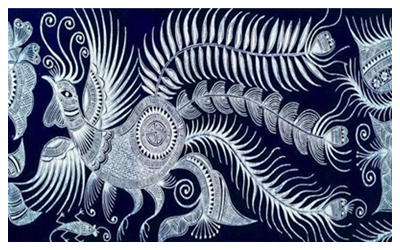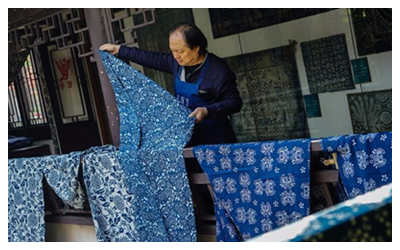- Home
- Travel In China > China Culture > Chinese Clothing >
Chinese Clothing Features

China is the birthplace of Dye Printing culture. The earliest excavated silk is a group of ribbons, threads, and woven fragments, all dyed red, dated to 3000 BC. In recent years, thousands of silk artifacts, including silk fragments, robes, textile paintings, and tapestries, most of which are beautifully dyed, have been unearthed by archaeologists in China.
The ancient dyeing technique of China was very superb and advanced. It could produce cloth with varied lustrous colors, and colors it dyed were not easy to wash out. Thus, this technique was called the mysterious Chinese art by Westerners. The dyeing methods roughly fell into four types: weaving of printed cloth , dye printing, embroidery and pattern drawing.
Traditional Chinese Dyes
Plant dyes were the dominant materials used for textile dyeing in ancient China. Chinese literary sources state that, as early as the Western Zhou Dynasty (1045–711 b.c.), a system of dyeing techniques was developed. The plant dyes used then include:

blue: indigo (Polygonum tinctorium)
red: madder (Rubia cordifolia)
purple: gromwell (Lithospermum erythrorhizon)
yellow: gardenia (Gardenia jasminoides Ellis)
black: hazel bark (Corylus chinensis)
During the Spring and Autumn Period (722–481 b.c.) and the Warring States Period (480–222 b.c.), mordant dying with plants containing tannic acid was widely used to yield black. The mordant employed was qing fan (iron salt). In addition to madder, safflower, which was introduced to China from the northwest tribes, became an important dyestuff during the Han Dynasty (202 b.c.–a.d. 220). It was taken to Japan in the Tang Dynasty (a.d. 618–960). During the Ming Dynasty (a.d. 1368–1644), numerous plants were employed from which dyes were extracted. In The Exploitation of the Works of Nature (Tian gong kai wu), Song Yingxing (b. 1587) reported four different plants from which indigo can be extracted, all widely planted as dyestuffs in China:
song lan(also known as cha lan): Isatis tinctoria L. var. yezoensis (ohwi) Ohwim
liao lan(also known as xian lan): Polygonum tinctorium
ma lan (distributed in northern China): Indigofera tinctoria L. and Strobilanthes cusis (Nees) O. ktze
wu lan (distributed in southern China, also known as mu lan, huai lan): Indigofera tinctoria L


 blue: indigo (Polygonum tinctorium)
blue: indigo (Polygonum tinctorium)  Ask Questions ?
Ask Questions ?